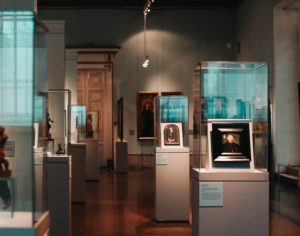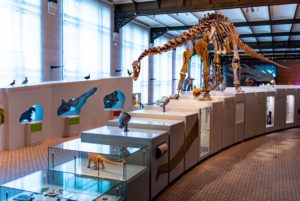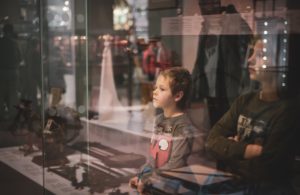The Many Hats of the Communication Practitioner in Nonprofit Museums
Published on Oct. 20, 2022, at 12:56 p.m.
by Annabelle Blomeley.
At McWane Science Center, kids ride a bike balanced on one piece of rope a dozen feet in the air, laughing and marveling at the wonders of physics that keep them suspended. Less than two hours north at the Cook Museum of Natural Science, kids and adults alike wander through caves, deserts and arctic tundras in authentically recreated exhibits. A little over an hour east, at the Guntersville Museum and Cultural Center, people follow the Tennessee River painted on the floor to look at everything from a 12-foot vintage fishing boat to regional Native American artifacts.
While these impressive and educational exhibits might be marvels to observe, some people may be surprised to find out that these institutions are all nonprofits.
A study conducted by IMPACTS found that the majority of people in the United States do not think cultural institutions are nonprofits. In fact, only 38.3% of respondents thought science museums were nonprofits, while 47.2% thought that most history museums were nonprofits.

Since nonprofits do not have to pay corporate income taxes because they benefit society, entities such as museums and educational institutions make most of their money from donations, ticket sales and merchandise sales. In fact, more than 60% of a museum’s revenue comes from individual donations and contributions.
Because nonprofits rely heavily on these donations, nonprofits are often stereotyped as having significantly less money and resources than corporations, especially when it comes to staffing. And in some cases, these stereotypes are true. Nonprofits are based on the fact that they are not-for-profit, meaning that donors and the public typically want extra money to go to the cause, instead of putting it toward staffing. In times of economic strife, some nonprofits have to make a difficult choice between staffing and keeping the operation afloat.
Since many nonprofits can’t afford to hire several professionals, museums tend to have small communication teams that perform the marketing, advertising and public relations work for the entire institution.
McWane Science Center
Miranda Springer, the vice president of development and marketing at McWane Science Center in Birmingham, Alabama, has been using her background in nonprofit fundraising and development to fulfill the marketing position, which was vacated two years ago when nearly half of the museum’s staff left during the COVID-19 pandemic.
At McWane, the marketing director fulfills all the communication roles, including marketing, public relations and advertising.

Although she didn’t have much experience in the communication field, Springer took the role head on, with help from a graphic designer and a digital marketing manager who work with her to tell the story of McWane Science Center.
“It’s always been my job to tell the story, to translate how the mission impacts the community, the region, the service population,” Springer said. “But it did take a little bit of education and trial and error for me to feel at least somewhat comfortable taking on the marketing role. But with COVID, many nonprofits had to get creative with how they made sure that the different roles and responsibilities were managed, especially when they were doing so with less staff.”
Springer said the stereotype of nonprofits with small communication teams typically derives from the limited amount of funding available.
“I think that’s why many nonprofits just neglect communications,” Springer said. “Nonprofit staff then have to wear a lot of different hats.”
With such a small team, Springer said McWane must balance donor relations and ticket sale revenue from the museum itself. Especially when the COVID-19 pandemic shut down most public attractions for several months, McWane had to turn to donations and contributions to earn revenue. In this regard, McWane Science Center had to put on its public relations hat to build and maintain the relationships that allowed the museum to stay afloat during the pandemic.
“We need to make organizations like ours be perceived as more than just a nice place to have in the community. We have to tell those stories about the impact on education, on the impact on underrepresented populations,” Springer said. “If we’re not making that case, then we are not going to build donor revenue.”
Springer said the greatest difficulty regarding communication for McWane has been telling this story in a way that paints the science center as more than just an attraction, but also a “valuable member of the science and education ecosystem.”
Cook Museum of Natural Science
In another part of this ecosystem, Joy Harris, the marketing coordinator for the Cook Museum of Natural Science in Decatur, Alabama, also fulfills all the museum’s communication needs, including public relations, advertising and marketing.
Despite the stereotype that nonprofits have no choice but to put communication positions on the back burner, Harris said she believes nonprofits understand the importance of communications more now than ever before.

“In the nonprofit world, usually people are wearing a lot of hats, and something like getting recognition may not be something that’s their top priority just because they’re actually trying to perform a service or have a product, so they’re really putting their emphasis on that,” Harris said. “It makes sense that it’s not going to be their first priority, but they’re only going to make it so far if they don’t promote themselves, because nonprofits have to rely on the public supporting them for them to be able to be successful. So, if the public doesn’t know what you’re doing, then they’re not going to donate.”
Harris said despite having to fulfill many roles in her position, she has found that most parts of the communication field work together, making her job a little easier.
“PR, advertising, graphic design, communications and marketing, it all helps build the picture of your nonprofit or your business to outsiders and the people that you’re wanting to address,” Harris said. “So, any way that you form that narrative of your company or your group, you’re going to have to bleed over into all the other different aspects.”
Harris said she also has help from the other areas in the museum that need her communication skills to further their own tasks at hand, such as donor relations and fundraising. Therefore, she said she always can get another set of eyes or help for her projects.
Guntersville Museum and Cultural Center
In smaller communities, like the lakeside tourist town of Guntersville, Alabama, sometimes the community comes together to help push public relations and advertising for their beloved museums.
Julie Patton, the director of the Guntersville Museum and Cultural Center, said she considers herself “a one-woman show.” She runs the museum, its marketing and communications, the exhibits, and everything else the museum needs to stay afloat.
Although Patton doesn’t technically have an extensive background in communications, she said she’s worked “parallel to communications,” which allows her to promote the museum with the help of an intern who runs the social media accounts.

According to a WorkLife article, more companies than ever before are turning to interns to manage their social media accounts in the constantly changing media landscape and during times of financial downturn.
While Patton only has one communication intern, the museum’s communications are built from her community of supporters and other prominent people around Guntersville.
“Communication is not just your ads and your social media and your magazine articles. It’s the relationships that you have in town, because I represent the museum wherever I go. So, at a chamber event, or even if I speak at the Rotary Club or at school, that is communication,” Patton said. “It’s really this whole huge world. It’s kind of all mixed up in who you meet, who you represent and the connections that you have. And then you know, the ads and the articles and the social media, to me, that’s extra.”
Patton said everyone, from the board members and tourism director to the volunteers and interns, helps her enact the museum’s mission by spreading the word and representing the museum in the community.
Despite potentially deterring stereotypes and economic struggles stemming from COVID-19, nonprofit museums are putting their own twists on their approaches to communications.




